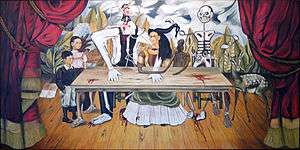The Wounded Table
| Spanish: La mesa herida | |
 | |
| Artist | Frida Kahlo |
|---|---|
| Year | 1940 |
| Medium | Oil on canvas |
| Dimensions | 122 cm × 244 cm (48 in × 96 in) |
| Condition | lost |
The Wounded Table (La mesa herida in Spanish) is an oil painting by Mexican artist Frida Kahlo. Although lost in 1955, three photos of this painting were taken between 1940 and 1944.[1] The painting was first displayed in January 1940 at the International Surrealism Exhibit at Inés Amor's Gallery of Mexican Art in Mexico City,[2] and a replica is currently displayed in the Kunstmuseum Gehrke-Remund, Baden-Baden, Germany.[3] The painting was last exhibited in Warsaw in 1955.[2]
The painting reflects ongoing themes in Kahlo's work, including Mexicanidad, indigeneity, self-portraiture, and grief/loss. Kahlo is seated at the center of the table where figures previously seen in her painting The Four Inhabitants of Mexico City also appear.[4] The table is spattered with blood and framed by a theatrical curtain, providing a stagelike setting, and she is surrounded by a precolumbian Nayarit figurine (part of her by now ex-husband Diego Rivera's collection), a papier-mâché skeleton (often called a Judas-like figure), two children, and her pet deer Granizo.[5]
In The Wounded Table, "Kahlo is no longer a bewildered child but an adult-sized Kahlo sitting at the table."[4] Kahlo bleeds as a martyr for Mexicanidad, she comments on the performative aspects of Mexican identity. It supports Roger Bartr’s analysis of post-revolutionary culture. In The Wounded Table, Kahlo parodies the stereotypes of mexicanness.[4]
"A Tehuana-clad Kahlo shares a long table with the cord- and dynamite-wrapped male figure and the skeleton of Four Inhabitants. Her long dark hair is lifted up and draped over the skeleton's arm, tying the two figures together. Seated between Kahlo and the skeleton is a small Nayarit sculpture. The long arm of the sculpture extends toward Kahlo and, near her shoulder, merges with hers. Blood oozes from wounds in the table, the man's feet, and the skeleton. It pools near the hem of the Tehuana dress and splatters onto the skirt. Blood is never far removed from the heart, and in this particular work the skeleton is touched by the bloodheart linking the skeletal death figure with the heart-life."[6]
References
- ↑ Remund, Mariella C. (March 20, 2010). "Frida Kahlo's The Wounded Table". Mexicolore. Archived from the original on March 16, 2015. Retrieved December 12, 2015.
- 1 2 Zamora, Martha; Kahlo, Frida; Smith, Marilyn Sode (1990-01-01). Frida Kahlo: the brush of anguish. San Francisco: Chronicle Books. ISBN 0877017468.
- ↑ "Frida Kahlo's {italic The Wounded Table}". www.mexicolore.co.uk. Retrieved 2016-03-04.
- 1 2 3 Andersen, Corrine (2009). "Remembrance of an Open Wound: Frida Kahlo and Post-revolutionary Mexican Identity". South Atlantic Review. 74 (4): 119–130. JSTOR 41337719.
- ↑ Deffebach, Nancy (2015-01-01). María Izquierdo and Frida Kahlo: challenging visions in modern Mexican art. ISBN 9780292772427.
- ↑ Helland, Janice. "Aztec Imagery in Frida Kahlo's Paintings: Indigenity and Political Commitment". Woman's Art Journal. 30 (2): 8–13. JSTOR 3690692.